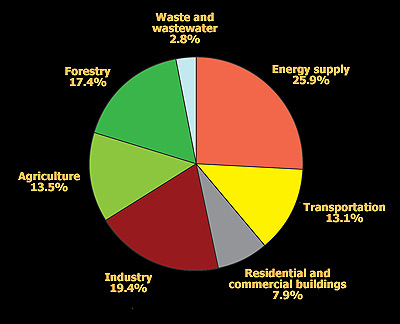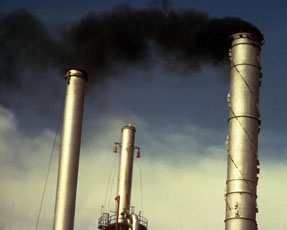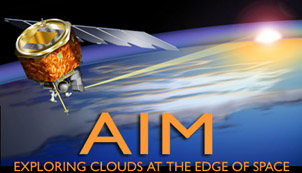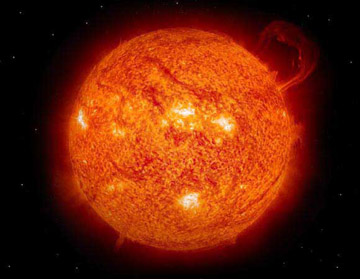Climate Change Mitigation Overview
Mitigation: trying to slow climate change by lowering the level of greenhouse gases (GHG) in the atmosphere, either by adding fewer GHG to the atmosphere or by developing ways to get them out.
In his Rough Guide to Climate Change, Robert Henson states that "the global-warming problem isn't going to be solved tomorrow, next week, or next year: we're in this one for the long haul. And there isn't one single solution. We need governments to agree and enforce targets; innovators to develop low-carbon energy sources and improve energy efficiency; and individuals to do their best to reduce their own carbon footprints."
A few weeks ago we explored ways in which communities are working together to mitigate the effects of urban heat islands, such as growing “green rooftops.” This week, we will focus on additional mitigation strategies. Mitigation involves attempts to slow the process of global climate change, usually by lowering the level of greenhouse gases in the atmosphere. Planting trees that absorb CO2 from the air and store it is an example of one such strategy.
At the core of most mitigation proposals is the reduction of greenhouse gas emissions through reducing energy use and switching to cleaner energy sources. Frequently discussed energy conservation methods include increasing the fuel efficiency of vehicles, making individual lifestyle changes, and changing business practices. Technologies such as hydrogen fuel cells, solar power, tidal energy, geothermal power, and wind power, along with the use of carbon sinks, carbon credits, and taxation, are aimed at countering greenhouse gas emissions more directly .
There is no shortage of ideas that might help mitigate the impact of climate change! Some are easy and inexpensive, such as replacing incandescent lights with compact fluorescent bulbs which use less electricity than their conventional counterparts. Many mitigation techniques, such as fuel cells and biofuels, are still in the development phase and will require further research to determine their usefulness and commercial viability. Some proposals, such as seeding the oceans with iron to increase phytoplankton populations (and draw more CO2 out of the air), sound more like science fiction and are unlikely to be implemented.
There are so many ideas and proposals that it would be impossible to cover them all in this course. Instead, we will focus on key mitigation technologies and practices that are currently available, along with some that are likely to be available in the near future.
Consider the table below, which lists numerous technologies that are currently available or are expected to become available within the next 25 years. Please keep in mind that these are practices that would be implemented by governments, communities, and industries—we will explore steps that families and individuals can take in a later reading.
| Sector | Key mitigation technologies and practices currently commercially available | Key mitigation technologies and practices projected to be commercialized before 2030 |
| Energy Supply |
Improved supply and distribution efficiency; fuel switching from coal to gas; nuclear power; renewable heat and power (hydropower, solar, wind, geothermal and bioenergy); combined heat and power; early applications of Carbon Capture and Storage (CCS, e.g. storage of removed CO2 from natural gas). | CCS for gas, biomass and coal-fired electricity generating facilities; advanced nuclear power; advanced renewable energy, including tidal and waves energy, concentrating solar, and solar PV. |
| Transport |
More fuel efficient vehicles, including hybrid vehicles, cleaner diesel vehicles, & biofuels. Shifting from road transport to rail and public transport systems. Increased non-motorized transport (cycling, walking, etc.). Improved land-use and transport planning. | Second generation biofuels; higher efficiency aircraft; advanced electric and hybrid vehicles with more powerful and reliable batteries. |
| Buildings |
Efficient use of lighting and daylighting. More efficient electrical appliances and heating & cooling devices. Improved cook stoves, insulation, and passive & active solar design for heating & cooling. Increased use of alternative refrigeration fluids and recovery & recycle of fluorinated gases. | Integrated design of commercial buildings including technologies, such as intelligent meters that provide feedback and control; solar PV integrated in buildings. |
| Industry |
More efficient end-use electrical equipment. Improved heat and power recovery; material recycling and substitution; control of non-CO2 gas emissions; and a wide array of process technologies used in industry. | Advanced energy efficiency; CCS for cement, ammonia, and iron manufacture; inert electrodes for aluminum manufacture. |
| Agriculture |
Improved crop and grazing land management to increase soil carbon storage; restoration of cultivated peaty soils and degraded lands; improved rice cultivation techniques and livestock and manure management to reduce CH4 emissions; improved nitrogen fertilizer application techniques to reduce N2O emissions; dedicated energy crops to replace fossil fuel use; improved energy efficiency. | Improvements of crops yields. |
| Forestry | Improved afforestation (the establishment of a new forest by seeding or planting on nonforested land); reforestation; forest management; reduced deforestation; harvested wood product management; use of forestry products for bioenergy to replace fossil fuel use. | Tree species improvement to increase biomass productivity and carbon sequestration. Improved remote sensing technologies for analysis of vegetation/ soil carbon sequestration potential and mapping land use change. |
| Waste Management |
Increased landfill methane recovery; waste incineration with energy recovery; composting of organic waste; controlled waste water treatment; recycling and waste minimization. | Biocovers and biofilters to optimize CH4 oxidation. |
Key mitigation technologies and practices by economic sectors. Sectors and technologies are listed in no particular order.
Adapted from Table SPM.3 in
the IPCC AR4 WG3 Summary for Policymakers.
There doesn't appear to be a shortage of steps that we can take to reduce our carbon emissions, but there is no single fix. Rather than exploring each of the sectors, along with their associated practices, we'll take a closer look at how one community is trying to reduce its climate impact before moving on to personal mitigation approaches.
A caveat: some of the technologies listed above may be associated with other environmental concerns (e.g. increased uranium mining and the subsequent need for nuclear waste storage that would be required by more nuclear power plants).















